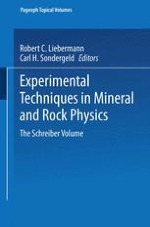1994 | OriginalPaper | Chapter
Experimental Simulation of Plagioclase Diagenesis at P-T Conditions of 3.5 km Burial Depth
Authors : Stephen L. Karner, B. Charlotte Schreiber
Published in: Experimental Techniques in Mineral and Rock Physics
Publisher: Birkhäuser Basel
Included in: Professional Book Archive
Activate our intelligent search to find suitable subject content or patents.
Select sections of text to find matching patents with Artificial Intelligence. powered by
Select sections of text to find additional relevant content using AI-assisted search. powered by
Dissolution of plagioclase under the physical conditions at shallow to intermediate burial depths is a prime candidate for secondary porosity generation in feldspathic siliciclastic sediments. The diagenetic behavior of granular aggregates of plagioclase feldspar and quartz has been investigated by experimentation performed in a Bridgeman-type pressure vessel. The experiments, each of two weeks duration, simulated pressure-temperature conditions approximating 3.5 km burial depth. By using a double-acting pore-fluid reservoir, solutions of various chemistries were cycled through samples composed of oligoclase or labradorite feldspar and quartz (90:10 wt% respectively).Scanning electron microscope analysis of the post-experiment samples reveals dissolution features and precipitated products. Dissolution voids of ∼ 10 microns occur typically in areas of maximum stress such as crack-tips and grain contacts. Dissolution on a larger scale is exemplified by topographical smoothing of grain surfaces. The dissolved species are subsequently reprecipitated as Ca-enriched overgrowths (possibly zeolites) and clays. These precipitates are found individually on the scale of 10 microns and collectively as surface coatings on both feldspar and quartz grains. Atomic absorption spectroscopic analyses of the pore fluid suggest that the fluid chemistry is consistent with the observed experimental precipitates.These experiments show that clay coatings are unnecessary precursors to grain surface dissolution and that the diagenetic precipitation is not mineral selective. Also, the mass transfer of the dissolved species appears to be localized because grains displaying both dissolution and precipitation features are commonplace. Volume changes due to mineral transformation/alteration may increase secondary porosity if the dissolved species produced from dissolution are only partially involved in reprecipitation and the remaining dissolved material is flushed out by the pore fluids. However, if the mass transfer is primarily local then permeability would significantly decrease as precipitates may choke the pore throats.
